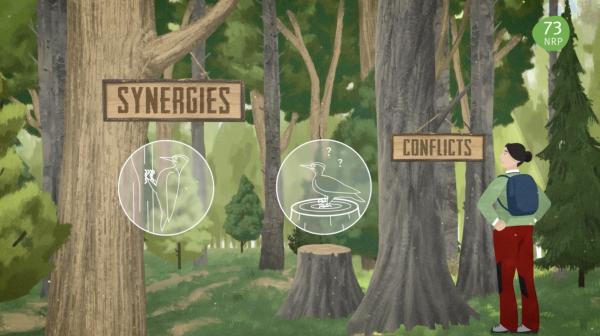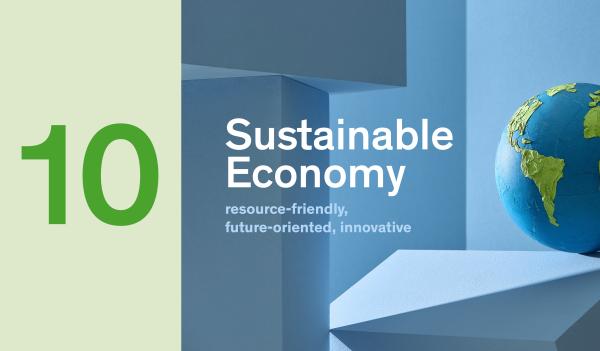Trade‐offs in forests
One claim on the forest arising from a sustainability transition is that it should compensate unmet environmental requirements of other sectors. This causes goal conflicts and forest management trade-offs. We identify policy solutions for two examples: carbon sequestration and clearances offsetting.

Background
The potentially growing sectors of a “sustainable economy” are competing for ever more scarce land and increasing the claims raised on the forest. While a growing “bioeconomy” poses an opportunity for the forest sector, on-going population growth, urbanisation and renewable energy strategies can also cause conflicting policy objectives and environmental trade-offs at the expense of forests that are expected to intensify in the future. Current forest policies and their instruments for balancing these trade-offs are being challenged and adaptations are called for.
Aim
The original aims of the project were:
- to identify nascent sustainable economy trade-offs from the perspective of the forest sector and to identify (market-based) policy instruments and instrument mixes for reconciling these trade-offs
- to assess the political feasibility of these instruments or instrument mixes by examining which are more acceptable to stakeholders and coalitions of actors in a case study region.
- to project the land-use implications of the suggested policy instruments or instrument mixes based on a spatially explicit simulation model
Results
The land-use competition dimension of forests
The analysis of forest clearance applications reveals that sustainable economy trade-offs imply a land-use competition dimension. Forests in the plateau and the alps are being cleared to create space for sustainable economy projects (e.g. geothermal-, wind-, hydro-, and biomass-power, “slow traffic”, i.e. foot and bicycle, recycling, etc.), although their share remains relatively small. The relevance of socio-economic determinants of the clearances’ locations cannot be established clearly. Topographical variables and landscape structure have more explanatory power in this respect.
Sustainable economy trade-offs
We suggest a concept of “sustainable economy trade-off” that differentiates between nascent and prevalent trade-offs as well as between goal conflicts at the policy programme level and trade-offs at the level of forest management.
We find that the forestry and wood sectors generally reject regulatory instruments, except regarding demands on the forest from other sectors. Artificial markets (i.e. markets that are induced by environmental regulation and caps on emissons or resource use and that distribute initial endowments of tradable emissions or usage rights) are expected to solve a variety of sustainable economy trade-offs as long as a strong regulatory framework protects traditional forest uses. We also identified property-rights based strategies as a possible means of enhancing the policy mix, particularly concerning small forest holders.
CO2 sequestration through forests
We have conducted a case study on CO2 sequestration and mitigation policy options including the forest (in the Canton of Lucerne) which shows that the wood and forest carbon sinks are accepted by a majority of more central and well-coordinated actors (i.e. the cantonal forest administration, the regional forest owner organisations, foresters, the wood processing industry). Also, a substantive share of younger, larger forest owners questioning the profitability of timber production embrace measures such as increasing the standing stock in forests and fuel wood, and supporting the wood sink, if they can generate sufficient income.
The other case study we conducted on forest clearances offsetting in the forest (Canton of Bern) confirms the strong goal conflict between sectoral policies competing for land. Some bilateral agreement between identified stakeholder coalitions points to feasible policy options (production-integrated offsetting or reafforestation on urban land) but market based-solutions are rejected. A majority of forest owners rejects forest clearances offsetting. A similar (though smaller) share of forest owners, as in the CO2 sequestration and mitigation case study, prefer such offsetting if it is limited to production-integrated measures at less profitable locations.
Implication for research
The project confirms the importance of land-use competition for goal conflicts across sectors (involving the forest sector), which is lacking in the literature. We are publishing a special issue in Forest Policy and Economics which highlights various dimensions of trade-offs arising from different demands on the forest and substantiates this conceptual approach with examples from various countries. In addition, our own two case studies identify feasible policy options for carbon sequestration and forest clearance offsetting (and biodiversity setting more generally) in the forest in an innovative way, i.e. by relating the preference structures of stakeholders and forest owners.
Implication for practice
The research on the forest clearances database sparked interest at the Federal Office for the Environment and resulted in a follow-up project. Pointing to potential negative implications of a sustainable economy transition for the forest helps to identify implementation deficits and increases awareness. The case studies included close collaboration with practitioners and addressed topical but highly complex issues. Identifying stakeholder coalitions and forest owner preferences to highlight potential policy reforms was well received by stakeholders and forest owners.
Publications
Project leaders
Dr. Tobias Schulz
Eidg. Forschungsanstalt für Wald
Schnee und Landschaft WSL
Dr. Astrid Zabel von Felten
Centre for Development and Environment (CDE), Universität Bern
Dr. Eva Lieberherr
Departement Umweltsystemwissenschaften
ETH Zürich
Project partners
Pan Bern AG




